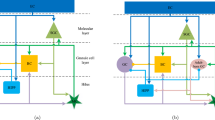Summary
A prominent feature of the mammalian cerebellum is its organization into parasagittal compartments. One marker of such compartments is the zebrin I molecule that is expressed by bands of Purkinje cells (PC). In order to understand better the basis for the development of this organization, we have transplanted dissociated rat cerebellar anlage, taken during the period of proliferation of PC precursors, into kainic acid lesioned adult rat cerebellum. As previously observed, the resultant grafts exhibited trilaminar structures reminiscent of the normal cerebellum. In every case, the PC in the resultant grafts were organized into zebrin I + and — compartments. In one case, most of the grafted PC were integrated into a region of PC deficient host molecular layer that was induced by pretreatment with kainic acid. Clear bands defined by zebrin I reactivity were seen where groups of the grafted PC had entered the host molecular layer. These bands did not correlate in distribution or size with host bands. Hypotheses compatible with these findings that involve specific and non-specific aggregation of PC are discussed.
Similar content being viewed by others
References
Altman J (1982) Morphological development of the rat cerebellum and some of its mechanisms. In: Palay SL, Chan-Palay V (eds) The cerebellum new vistas. Exp Brain Res Suppl 6:8–46
Armengol JA, Sotelo C, Angaut P, Alvarado-Mallart RM (1989) Organization of host afferents to cerebellar grafts implanted into kainate lesioned cerebellum in adult rats. Eur J Neurosci 1:75–93
Arsenio-Nunes ML, Sotelo C (1983) Development of the spinocerebellar system in the postnatal rat. J Comp Neurol 237:291–306
Ezerman EB, Kromer LF (1985) Development and neuronal organization of dissociated and reaggregated embryonic cerebellum after intracephalic transplantation to adult rodent recipients. Dev Brain Res 23:287–292
Gravel C, Eisenman L, Sasseville R, Hawkes R (1987) Parasagittal organization of the rat cerebellar cortex: a direct correlation between antigenic bands revealed by mab Q113 and the topography of the olivocerebellar projection. J Comp Neurol 265:294–310
Hawkes R, Leclerc N (1986) Immunocytochemical demonstration of topographic ordering of Purkinje cell axon terminals in the fastigial nuclei of the rat. J Comp Neurol 244:481–491
Hawkes R, Colonnier M, Leclerc N (1985) Monoclonal antibodies reveal sagittal banding in the rodent cerebellar cortex. Brain Res 333:359–365
Jande SS, Maler L, Lawson DME (1981) Immunohistochemical mapping of vitamin D-dependent calcium binding protein in brain. Nature 294:765–767
Leclerc N, Gravel C, Hawkes R (1988) Development of parasagittal zonation in the rat cerebellar cortex: Mab Q113 antigenic bands are created postnatally by the suppression of antigen expression in a subset of Purkinje cells. J Comp Neurol 273:399–420
Sotelo C, Alvarado-Mallart RM (1986) Growth and differentiation of cerebellar suspensions transplanted into the adult cerebellum of mice with heredodegenerative ataxia. Proc Nat Acad Sci (USA) 83:1135–1139
Sotelo C, Alvarado-Mallart RM (1987) Reconstruction of the defective cerebellar circuitry in adult Purkinje cell degeneration mutant mice by Purkinje cell replacement through transplantation of solid embryonic implants. Neuroscience 20:1–22
Sotelo C, Bourrat F, Triller A (1984) Postnatal development of the inferior olivary complex in the rat. II. Topographic organization of the immature olivocerebellar projection. J Comp Neurol 222:177–199
Sotelo C, Alvarado-Mallart RM, Gardette R, Crepel F (1990) The fate of grafted embryonic Purkinje cells in the cerebellum of the adult “Purkinje cell degeneration” mutant mouse. I. Development of reciprocal graft-host interactions. J Comp Neurol 295:165–187
Waechter R, Jaensch B (1972) Generation times of the matrix cells during embryonic brain development: an autoradiographic study in rats. Brain Res 46:235–250
Wassef M, Angaut P, Arsenio-Nunes ML, Bourrat F, Sotelo C (1990a) Purkinje cell heterogeneity: its role in organizing the topography of the cerebellar cortex connections. In: Llinas R, Sotelo C (eds) Neurobiology of cerebellar systems (in press)
Wassef M, Sotelo C, Thomasset M, Granholm A-C, Leclerc N, Rafrafi J, Hawkes R (1990b) Expression of compartmentation antigen zebrin I in cerebellar transplants. J Comp Neurol 294:223–234
Author information
Authors and Affiliations
Rights and permissions
About this article
Cite this article
Rouse, R.V., Sotelo, C. Grafts of dissociated cerebellar cells containing Purkinje cell precursors organize into zebrin I defined compartments. Exp Brain Res 82, 401–407 (1990). https://doi.org/10.1007/BF00231259
Received:
Accepted:
Issue Date:
DOI: https://doi.org/10.1007/BF00231259




